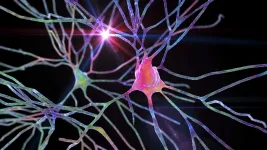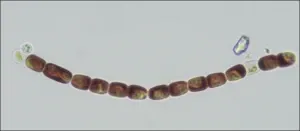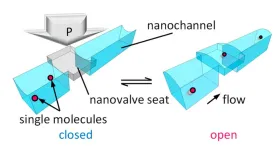(Press-News.org) Every cell in our body is able to turn genes (DNA) on or off, producing RNA, but when genes are ‘turned on’ to the wrong level it can result in a variety of health conditions.
Rett syndrome is a rare neurodevelopmental condition that causes a loss of motor and language skills over time in girls. The condition is caused by a genetic variation in the MECP2 gene located on the X chromosome, resulting in affected nerve cells in the brain expressing the wrong levels of more than one thousand genes. The end result is that Rett syndrome nerve cells are smaller, less interconnected and less electrically active than healthy controls.
In a study published in Nature Communications, researchers at The Hospital for Sick Children (SickKids) in the Dr. James Ellis Lab show that for people with Rett syndrome, nerve cells have a way to partially compensate for these genetic changes through a process called transcriptional buffering.
Using stem cells from a patient with Rett syndrome, the researchers grew nerve cells and employed a special type of RNA sequencing called RATESeq. With the help of collaborating labs led by Drs. Mike Wilson and Olivia Rissland, RATESeq allowed the team to directly measure how fast new RNA is made and broken down in cells.
“This study is one of the first in the world that combines measurements of both transcription and the breakdown of RNA molecules in human disease,” says Dr. Deivid Rodrigues, co-first author of the paper and a Research Associate in the Developmental & Stem Cell Biology program at SickKids. “What we found revealed exciting new insight that transcriptional buffering occurs in Rett syndrome nerve cells, driven by changes in RNA stability.”
What is transcriptional buffering?
RNA is made through a process known as transcription, which happens in the cell nucleus. Proteins then bind the RNA and transport it to the cell cytoplasm where it is eventually broken down.
In the absence of the MECP2 gene in Rett syndrome nerve cells, the cell nucleus turns genes on to the wrong level and produces either too much or too little RNA. Rodrigues and co-first author Marat Mufteev, a PhD student in the Department of Medical Genetics at the University of Toronto, found that when the wrong levels of RNA are transferred to the cytoplasm their stability changes. The cells balance the total amount of RNA produced in a process called transcriptional buffering.
Using machine learning, the researchers showed that transcriptional buffering uses proteins that bind to RNA and shuttle it from the nucleus to the cytoplasm, where they control RNA breakdown. In Rett syndrome, only about half of the genes are transcriptionally buffered leading to modest, but impactful, two-fold changes in RNA levels.
“For people with Rett syndrome, the process of making RNA is like a novice driver in a car struggling with jerky accelerations and screeching stops,” explains Dr. James Ellis, lead author and Senior Scientist in the Developmental & Stem Cell Biology program. “One way to moderate these exaggerated movements is by using a ‘cruise control’ system that can maintain a constant speed. This is done in the human brain by transcriptional buffering.”
‘Cruise control’ system defends against RNA changes
By safeguarding the healthy levels of so many genes, transcriptional buffering acts as a defence against genetic variations that change RNA production, such as those seen in Rett syndrome. It reveals a new molecular mechanism in human cells that may also play an important role in regulating RNA levels in typical development.
“While our research is currently limited to Rett syndrome, we are hopeful that by better understanding transcriptional buffering we can gain new insights into the development of typical cells and conditions whose effects reach beyond nerve cells,” says Ellis.
The researchers note a greater understanding of the buffering mechanism may help future investigations into using transcriptional buffering to help treat the effects of Rett syndrome.
The study was funded by the Canadian Institutes of Health Research (CIHR), the Canada First Research Excellence Fund, the Col. Harland Sanders Rett Syndrome Research Fund at the University of Toronto, the Ontario Brain Institute, the John Evans Leaders Fund/Canada Foundation for Innovation, an Early Researcher Award from the Ontario Ministry of Research and Innovation, and a Genome Canada Disruptive Innovation in Genomics Grant.
END
Cellular “cruise control” system safeguards RNA levels in Rett syndrome nerve cells
2023-05-02
ELSE PRESS RELEASES FROM THIS DATE:
Study finds gender pay differences begin early, with the job search
2023-05-02
A new paper in the Quarterly Journal of Economics, published by Oxford University Press, indicates that an important part of the pay gap between men and women has to do with how they conduct job searches, with women more likely to accept job offers early while men tend to hold out for higher pay.
Women in the United States earn 84% of what men earn, as of 2020. This disparity is well documented, and economists and the general public have known about the earnings difference for decades. The reasons for this phenomenon are a matter of considerable debate.
Initial conditions in the labor market are long-lasting. Young workers who begin ...
Single-molecule valve: a breakthrough in nanoscale control
2023-05-02
Scientists dream of using tiny molecules as building blocks to construct things, similar to how we build things with mechanical parts. However, molecules are incredibly small - around one hundred millionth the size of a softball - and they move randomly in liquids, making it very difficult to manipulate them in a single form. To overcome this challenge, “nanofluidic devices” that can transport molecules in extremely narrow channels, similar in size to one millionth of a straw, are attracting attention ...
The science behind the life and times of the Earth’s salt flats
2023-05-02
AMHERST, Mass. – Researchers at the University of Massachusetts Amherst and the University of Alaska Anchorage are the first to characterize two different types of surface water in the hyperarid salars—or salt flats—that contain much of the world’s lithium deposits. This new characterization represents a leap forward in understanding how water moves through such basins, and will be key to minimizing the environmental impact on such sensitive, critical habitats.
“You can’t protect the salars if you don’t first understand how they work,” says Sarah McKnight, lead author of the research that appeared recently ...
HIV status is not associated with mpox treatment outcomes in persons using tecovirimat
2023-05-02
Embargoed for release until 5:00 p.m. ET on Monday 01 May 2023
Annals of Internal Medicine Tip Sheet
@Annalsofim
Below please find summaries of new articles that will be published in the next issue of Annals of Internal Medicine. The summaries are not intended to substitute for the full articles as a source of information. This information is under strict embargo and by taking it into possession, media representatives are committing to the terms of the embargo not only on their own behalf, but also on behalf of the organization they represent.
----------------------------
1. ...
Juvenile salmon migration timing responds unpredictably to climate change
2023-05-02
Climate change has led to earlier spring blooms for wildflowers and ocean plankton but the impacts on salmon migration are more complicated, according to new research.
In a new study, published in the journal Nature, Ecology & Evolution, Simon Fraser University (SFU) researcher Sam Wilson led a set of diverse collaborators from across North America to compile the largest dataset in the world on juvenile salmon migration timing. The dataset includes 66 populations from Oregon to B.C. to Alaska. Each dataset was at least 20 years in length with the longest dating back to 1951. Only wild salmon, and not salmon from hatcheries, ...
State study: labor induction doesn’t always reduce caesarean birth risk or improve outcomes for term pregnancies
2023-05-02
ANN ARBOR, Mich. – In recent years, experts have debated whether most birthing individuals would benefit from labor induction once they reach a certain stage of pregnancy.
But a new statewide study in Michigan suggests that inducing labor at the 39th week of pregnancy for people having their first births with a single baby that is in a head down position, or low risk, doesn’t necessarily reduce the risk of caesarian births. In fact, for some birthing individuals, it may even have the opposite effect if hospitals don’t take a thoughtful approach to ...
OSU-Cascades researcher explores AI solution for tracking and reducing household food waste
2023-05-02
BEND, Ore. – A researcher at Oregon State University-Cascades has received funding to develop a smart compost bin that tracks household food waste.
The project led by Patrick Donnelly, assistant professor of computer science in the OSU College of Engineering, seeks to make a dent in a multi-billion-dollar annual problem in the United States: More than one-third of all food produced in the U.S. goes uneaten.
“At every other step of the agricultural supply chain, food waste is tracked, measured and quantified,” Donnelly ...
Survival from cardiac arrest less likely in Asian American Pacific Islander communities
2023-05-02
DALLAS, May 1, 2023 — Science tells us that when a cardiac arrest happens, bystander CPR can double or even triple the chances of survival.[1] Asian American and Pacific Islander (AAPI) adults who experience cardiac arrest outside of a hospital setting have a substantially lower chance of receiving bystander CPR.[2] During Asian American Pacific Islander Heritage month in May, the American Heart Association, a global force for healthier lives for all, is asking people to “Be the Beat” for their family and learn Hands-Only ...
Your health is in your hands during American Stroke Month
2023-05-02
DALLAS, May 1, 2023 — Strokes can happen to anyone, at any age. In fact, globally about one in four adults over the age of 25 will have a stroke in their lifetime.[1] During American Stroke Month, the American Stroke Association, a division of the American Heart Association, as part of a nationally supported collaboration with HCA Healthcare and the HCA Healthcare Foundation, will teach people everywhere that stroke is largely preventable, treatable and beatable.
A stroke happens when normal blood flow in the brain is interrupted. When parts of the ...
Blocking a tiny RNA may forestall age-related bone and muscle loss, inflammation
2023-05-02
AUGUSTA, Ga. (May 2, 2023) – Inhibiting a tiny RNA whose levels significantly increase with age, along with problems like weaker bones and sagging muscles, may be a way to keep our bodies more youthful and healthy, scientists say.
MicroRNAs help regulate gene expression and consequently the function of our cells, and several, including one called microRNA-141-3p, have been implicated in the ills of aging, like increasing levels of potentially damaging chronic inflammation and that shrinking muscle mass.
“When we age in all these complications like chronic inflammation, muscle loss, bone loss, this microRNA is elevated,” says Sadanand ...






